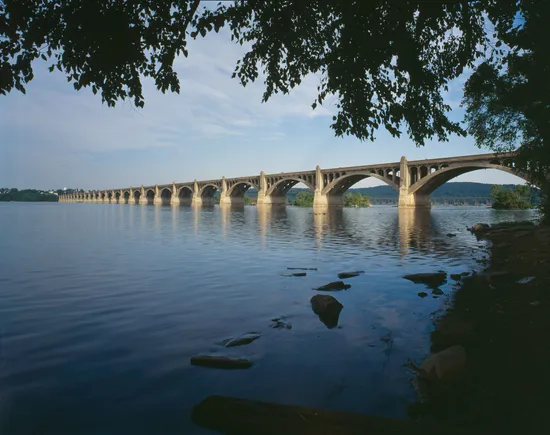Dive Brief:
- More than a third of the country’s bridges need major repair work or replacement, according to the American Road & Transportation Builders Association’s analysis of the U.S. DOT’s National Bridge Inventory data, pulled on Aug. 20.
- In total, 36% or 221,800 bridges need repair and 76,175 should be replaced entirely, per ARTBA’s report, which provides a snapshot in time of the nation’s bridge conditions. Plus, 49% of U.S. bridges were in fair condition, which means key elements of the structure got a middling grade.
- Over the last five years, the share of bridges in fair condition has continued to grow as the share of structures classified in “poor” or “good” condition declined. There are signs of progress though, with 324 fewer bridges rated in poor condition and structurally deficient this year than in 2023.
Dive Insight:
Many of the country’s bridges are already ailing, and extreme weather in a changing climate is stressing them beyond what they were originally designed to withstand. A study in the journal PLOS ONE found that extreme temperatures could cause one in four of the country’s steel bridges to collapse by 2050.
About a quarter of the country’s bridges were built before 1960, according to the New York Times, and higher heat and increased flooding driven by climate change are making them age even more quickly. Sharp temperature swings make bridges rapidly swell and contract, leaving them weakened. That’s of particular concern with the world on track to notch its hottest year on record for the second year in a row.

ARTBA broke out the number of bridges that need work by type of repair they require.
Courtesy of ARTBA
ARTBA estimates it would cost at least $400 billion to make all needed repairs, not taking into account future climate stressors.
The 2021 Infrastructure Investment and Jobs Act provides additional funding for bridges. States have received $15.9 billion in the first three years of the IIJA’s new $27.5 billion formula bridge program and have committed 46% of these resources to at least 4,170 bridge projects. The remaining 54%, or $8.5 billion, of already-released bridge funds and the $10.6 billion that will be provided in the next two years will further support bridge improvements, per ARTBA.
Another new IIJA initiative, the Bridge Investment Program, provides an additional $12.5 billion for projects that will be awarded through 2026. So far the program has awarded $7.8 billion for 87 planning, small and large bridge project grants in over 40 states, according to ARTBA.
But that still leaves a funding gap of over $350 billion, based on ARTBA’s $400 billion estimate.
Measuring bridge health
The state of the nation’s bridge stock is slowly improving, according to an ARTBA news release. Bridges in poor condition represent 6.8% of the 2024 U.S. bridge inventory, ticking down from 7.3% in 2020.
“Over the last five years we have seen significant progress in states like Oklahoma, Pennsylvania, Mississippi, Louisiana, and West Virginia – reducing the number of bridges in poor condition,” said ARTBA Chief Economist Alison Premo Black, who conducted the analysis, in a release. “While improvements can take time, every bridge repair increases the safety and efficiency of our network for the traveling public.”
States with the biggest decline in the number of bridges in poor condition include:
- Pennsylvania, down 90 bridges.
- Louisiana, down 87.
- Florida, down 85.
- West Virginia, down 74.
- California, down 64.
However, the number of bridges in poor condition rose in New York (up 86), Kentucky (up 60), South Carolina (up 59), Illinois (up 45) and Puerto Rico (up 38).
Bridges are classified in good, fair or poor condition based on their inspection ratings and definitions from the Transportation Department. The definition of “poor” is when a key element of the bridge — the deck, superstructure, substructure or culverts — are rated in poor or worse condition, according to ARTBA.
Most bridges are inspected every two years, meaning repairs underway or in the planning stages can take time to be reflected in the National Bridge Inventory data.
